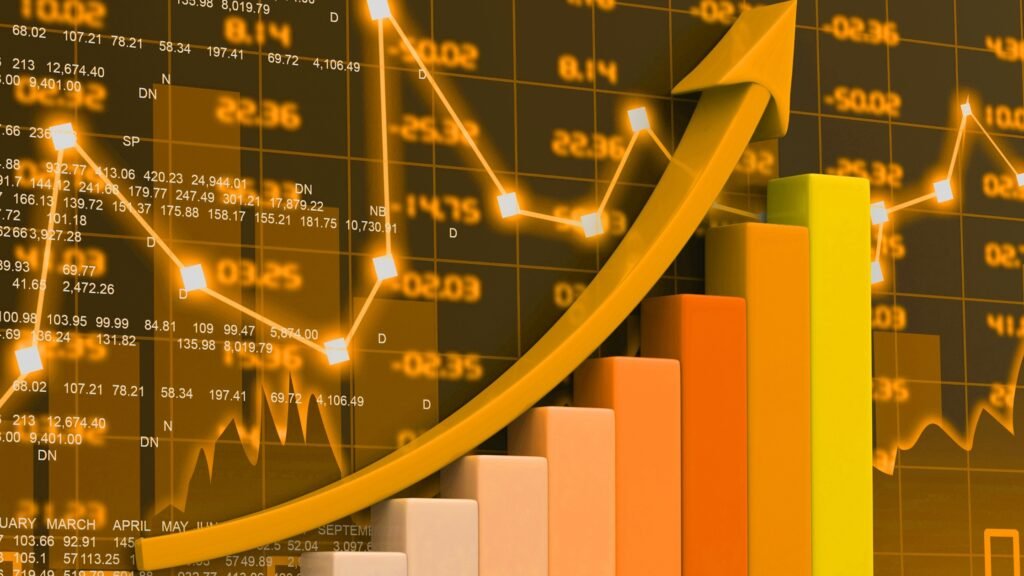The Dow Jones stock markets are one of the most critical indicators of the global economy. Whether you’re a seasoned investor or a curious beginner, understanding how the Dow Jones operates can help you make better financial decisions. In this article from Chandigarh UT’s Business and Economy section, we’ll explain the Dow Jones in simple terms, explore its components, and uncover why it matters for both Wall Street and Main Street.

What is the Dow Jones Stock Markets?
The Dow Jones stock markets refer to stock market indexes developed by Dow Jones & Company, particularly the Dow Jones Industrial Average (DJIA)—one of the oldest and most widely recognized benchmarks in the world.
Key Points:
- The DJIA tracks 30 major U.S. companies.
- It is price-weighted, meaning stocks with higher prices have more influence.
- It serves as a barometer for the U.S. stock market and economy.
- It is managed by S&P Dow Jones Indices, a joint venture between S&P Global, the CME Group, and News Corp.
Table: Overview of Dow Jones Stock Markets
| Feature | Details |
|---|---|
| Index Name | Dow Jones Industrial Average (DJIA) |
| Founded | 1896 |
| Number of Companies | 30 |
| Index Type | Price-weighted |
| Primary Exchange | New York Stock Exchange (NYSE), NASDAQ |
| Tracked Sectors | Industrial, Technology, Healthcare, Financial, Consumer Goods, etc. |
| Operator | S&P Dow Jones Indices (a joint venture including S&P Global) |
1. How is the Dow Jones Stock Markets Calculated?
The Dow Jones stock markets, particularly the Dow Jones Industrial Average (DJIA), use a price-weighted index method for calculation. This is different from indices like the S&P 500, which are market-cap-weighted.
Simple Breakdown of the Dow Jones Calculation:
To understand how the Dow Jones stock markets index value is derived, let’s walk through the process step by step:
- Add the Stock Prices of All 30 Companies
The DJIA includes 30 prominent publicly-traded companies in the U.S., covering various industries. These are large, established firms such as Apple, Boeing, and Goldman Sachs. First, the individual stock prices of these 30 companies are added together. - Divide by the Dow Divisor
The total of these prices is then divided by a special number called the Dow Divisor. This number is not constant — it is adjusted over time to account for events like:- Stock splits
- Spinoffs
- Dividends
Example:
Let’s say the sum of all 30 stock prices is $4,500, and the current Dow Divisor is 0.15.
Dow Jones Index = Total Stock Prices / Dow Divisor
Dow Jones Index = $4,500 / 0.15 = 30,000 pointsThis final figure — 30,000 points in this case — is what’s reported as the Dow Jones Industrial Average on financial news platforms.
Why is it Price-Weighted?
In a price-weighted index, companies with higher stock prices have a larger influence on the index’s movement, regardless of their overall size (market cap). For example, if a $300 stock moves up by $5, it affects the index more than a $50 stock moving up by the same amount.
Criticisms of the Price-Weighted Method:
- It gives more weight to high-priced stocks, even if they’re smaller companies.
- It may not accurately reflect the performance of the overall economy.
Despite these criticisms, the Dow Jones stock markets index remains one of the oldest and most widely recognized benchmarks of U.S. stock performance. more weight to high-priced stocks, even if those companies are smaller in value compared to others.
1. How is the Dow Jones Stock Markets Calculated?
The Dow Jones stock markets, particularly the Dow Jones Industrial Average (DJIA), use a price-weighted index method for calculation. This is different from indices like the S&P 500, which are market-cap-weighted.
Simple Breakdown of the Dow Jones Calculation:
To understand how the Dow Jones stock markets index value is derived, let’s walk through the process step by step:
- Add the Stock Prices of All 30 Companies
The DJIA includes 30 prominent publicly-traded companies in the U.S., covering various industries. These are large, established firms such as Apple, Boeing, and Goldman Sachs. First, the individual stock prices of these 30 companies are added together. - Divide by the Dow Divisor
The total of these prices is then divided by a special number called the Dow Divisor. This number is not constant — it is adjusted over time to account for events like:- Stock splits
- Spinoffs
- Dividends
Example:
Let’s say the sum of all 30 stock prices is $4,500, and the current Dow Divisor is 0.15.
Dow Jones Index = Total Stock Prices / Dow Divisor
Dow Jones Index = $4,500 / 0.15 = 30,000 pointsThis final figure — 30,000 points in this case — is what’s reported as the Dow Jones Industrial Average on financial news platforms.

Why is it Price-Weighted?
In a price-weighted index, companies with higher stock prices have a larger influence on the index’s movement, regardless of their overall size (market cap). For example, if a $300 stock moves up by $5, it affects the index more than a $50 stock moving up by the same amount.
Criticisms of the Price-Weighted Method:
- It gives more weight to high-priced stocks, even if they’re smaller companies.
- It may not accurately reflect the performance of the overall economy.
Despite these criticisms, the Dow Jones stock markets index remains one of the oldest and most widely recognized benchmarks of U.S. stock performance.
2. Why is the Dow Jones Stock Markets Important?
The Dow Jones stock markets are crucial to both national and international financial systems. Their importance stems from a variety of economic, historical, and psychological factors that influence both investor behavior and government policy.
1. Investor Sentiment
The Dow acts as a barometer of investor confidence. When the Dow is rising, it signals that investors are optimistic about the economy and company earnings. When it falls, it often indicates fear or uncertainty. This makes it a powerful tool for gauging the market’s emotional pulse.
2. Media Benchmark
Financial media, such as Bloomberg, CNBC, and The Wall Street Journal, regularly cite the Dow Jones stock markets in headlines and updates. It’s an easy-to-understand indicator of how the market is performing on any given day, making it the go-to index for public consumption.
3. Historical Trends
Since its inception in 1896, the Dow has documented the economic history of the U.S.. Analysts use its long-term performance to:
- Analyze market cycles
- Understand recession and recovery patterns
- Benchmark past and present financial events
4. Policy Reactions
Movements in the Dow can even influence decisions by the Federal Reserve and U.S. government. For example, during periods of steep declines, central banks may intervene with stimulus measures or rate cuts to stabilize the economy.
5. Global Relevance
The Dow Jones stock markets have global reach. International investors, governments, and corporations monitor the Dow to gauge the health of the U.S. economy. Since the U.S. is a global financial powerhouse, the Dow’s movements often correlate with:
- Currency fluctuations
- Foreign market reactions
- Global commodity prices
In short, the Dow isn’t just a stock index—it’s a global economic indicator.
3. What Companies Are in the Dow Jones Stock Markets?
Here are 10 major companies currently in the DJIA (as of 2025):
| Company Name | Sector |
| Apple Inc. | Technology |
| Microsoft Corporation | Technology |
| The Coca-Cola Company | Consumer Staples |
| Boeing Co. | Industrial |
| Johnson & Johnson | Healthcare |
| Goldman Sachs Group | Financial Services |
| McDonald’s Corporation | Consumer Discretionary |
| Visa Inc. | Financial Technology |
| Intel Corporation | Technology |
| Chevron Corporation | Energy |
The full list includes 30 companies across diverse industries.
4. People Also Ask (FAQs)
What does the Dow Jones tell us?
The Dow shows how 30 top publicly traded companies are performing, which reflects the overall health of the U.S. economy.
Is the Dow Jones the same as the stock market?
Not exactly. The Dow Jones stock markets are a part of the broader stock market. Other indexes like the S&P 500 and NASDAQ Composite offer different perspectives.
Can I invest in the Dow Jones directly?
You can’t buy the index itself, but you can invest in ETFs (like DIA) that track the Dow.
How often does the Dow Jones change its components?
It changes rarely—only when a company no longer fits the index’s criteria or to reflect industry changes.
How does the Dow differ from the NASDAQ and S&P 500?
- Dow Jones: 30 large-cap U.S. companies, price-weighted.
- S&P 500: 500 companies, market-cap weighted.
- NASDAQ: Tech-heavy, includes more growth stocks.
5. Major Historical Events in Dow Jones Stock Markets
| Event | Date | Impact |
| Great Depression Crash | 1929 | Dow fell nearly 90% from peak |
| Dot-com Bubble Burst | 2000–2002 | Technology-led declines |
| Global Financial Crisis | 2008 | Major banks collapsed, Dow tumbled |
| COVID-19 Market Crash | 2020 | Fastest 30% drop in history |
| Post-Pandemic Recovery | 2021–2023 | Record highs driven by tech sector |
6. Different Types of Dow Jones Indexes
While most people refer to the DJIA when they say “Dow Jones,” there are several Dow Jones indexes:
Key Types:
- Dow Jones Industrial Average (DJIA) – 30 blue-chip companies
- Dow Jones Transportation Average (DJTA) – Airlines, railroads, delivery services
- Dow Jones Utility Average (DJUA) – Utility companies
- Dow Jones Composite Average – Combines the above three
- Dow Jones Global Indexes – Tracks companies outside the U.S.
Each of these indexes reflects the performance of different economic sectors or global regions.
7. ETFs That Track Dow Jones Stock Markets
If you want to invest in the Dow Jones stock markets, these ETFs are your best options:
| ETF Name | Ticker | Description |
| SPDR Dow Jones Industrial | DIA | Most popular Dow-tracking ETF |
| ProShares Ultra Dow30 | DDM | Leverage ETF offering 2x exposure |
| Invesco Dow 30 Equal Weight | EDOW | Equally weighted Dow components |
ETFs are great because they offer diversification, liquidity, and lower risk for beginner investors.
8. How to Analyze the Dow Jones Stock Markets?
Tools You Can Use:
- Moving Averages (SMA & EMA)
- MACD (Moving Average Convergence Divergence)
- RSI (Relative Strength Index)
- Volume Trends
Consider These Factors:
- Earnings Reports
- Inflation Data
- Fed Interest Rate Announcements
- Global Events (wars, pandemics, etc.)
Analyzing these can help investors make better-informed decisions.
9. Impact of Dow Jones Stock Markets on Indian Investors
Many Indian investors keep an eye on the Dow Jones stock markets because:
- U.S. market trends influence Indian markets (NIFTY, SENSEX)
- Many Indian mutual funds and ETFs include U.S. equities
- Global diversification strategies include Dow-based ETFs
Conclusion: Why You Should Follow the Dow Jones Stock Markets
The Dow Jones stock markets are not just numbers on a screen—they are a living indicator of economic strength, corporate health, and market sentiment. Whether you’re watching from India or investing globally, keeping track of the Dow can offer essential insights for your financial strategy.
For more informative guides on business, economy, and investments, explore the Business and Economy section on Chandigarh UT.
Want to Stay Updated on the Global Economy?
Visit Chandigarh UT for the latest insights on finance, economy, and market trends!















